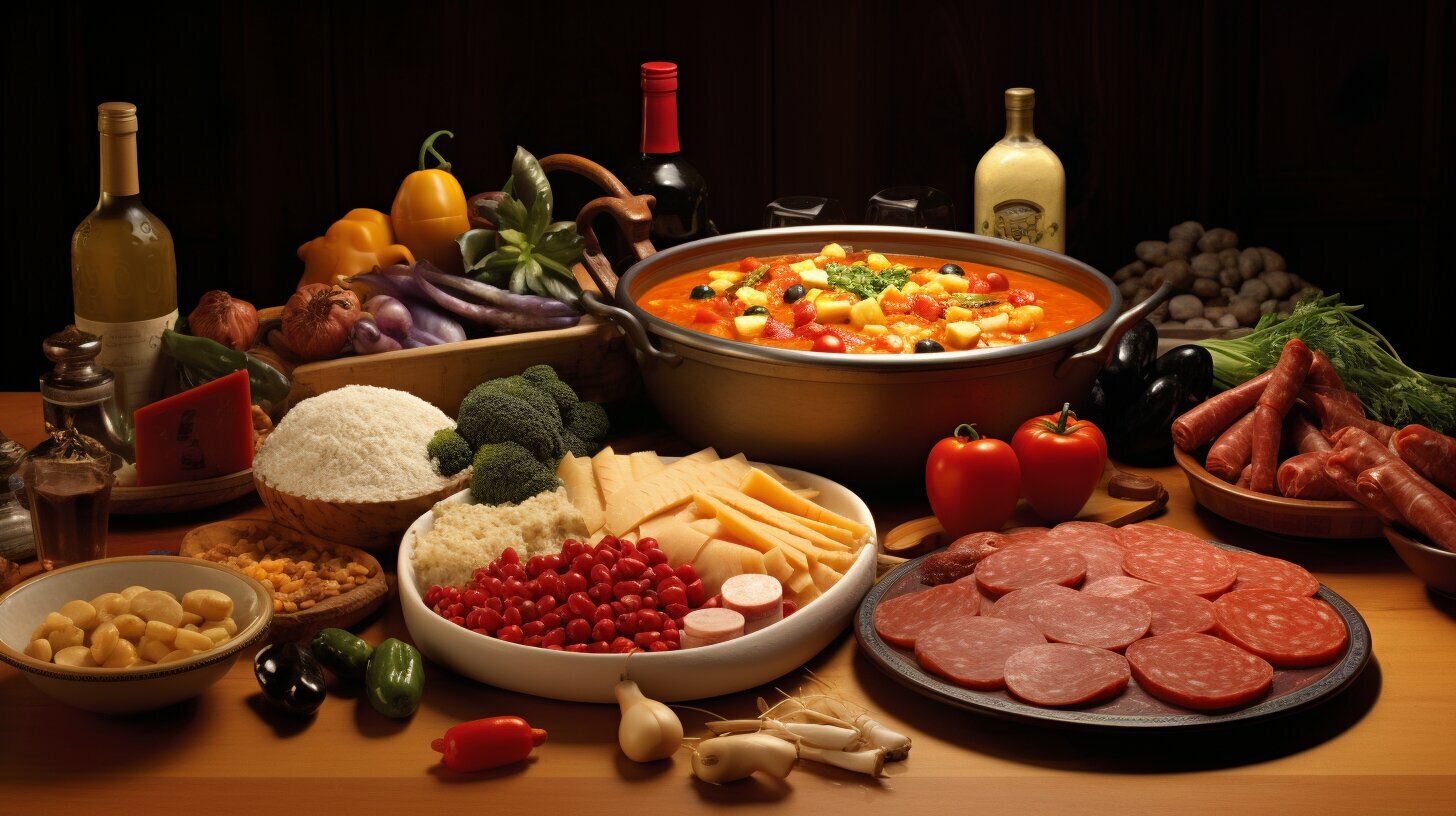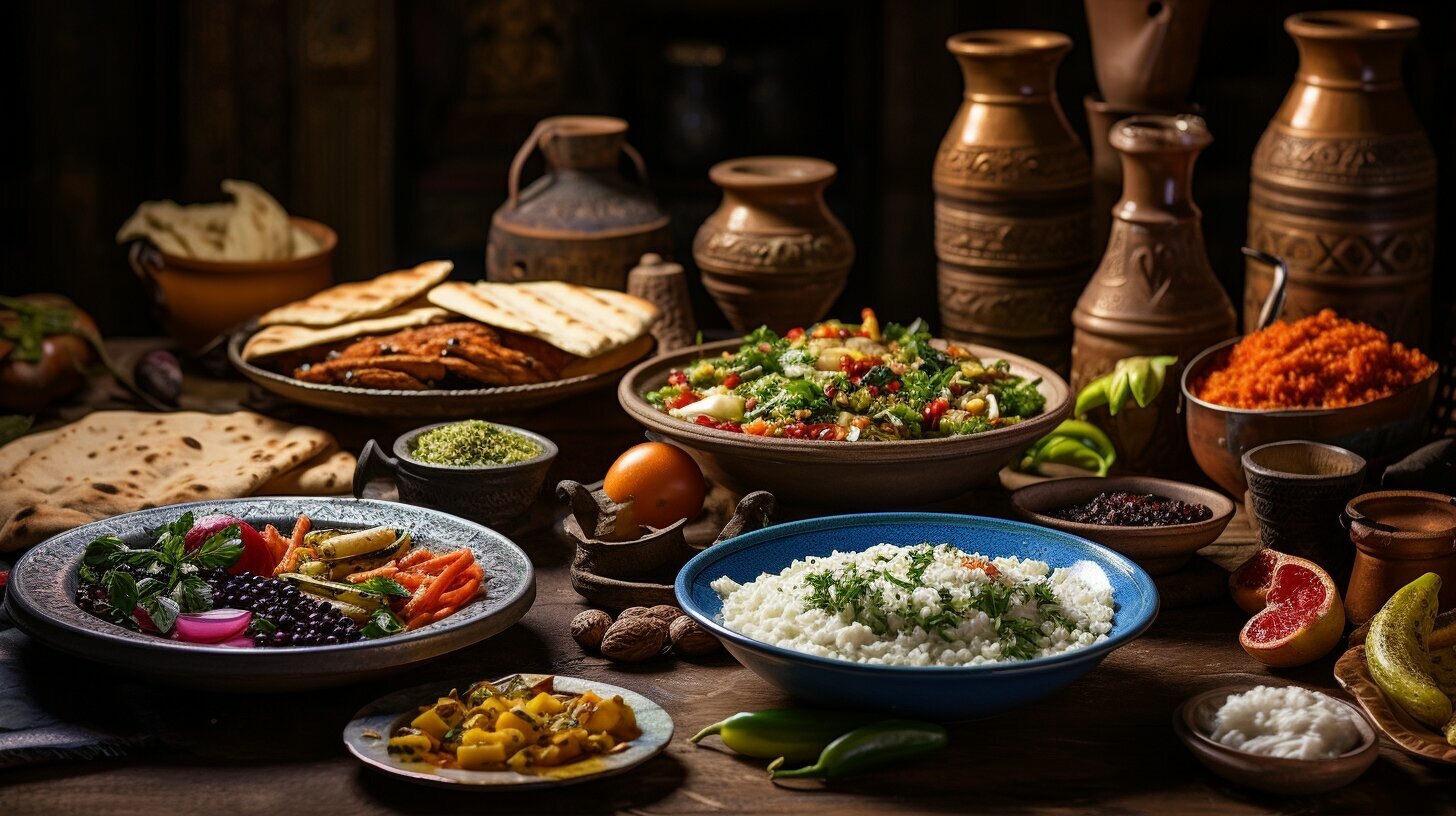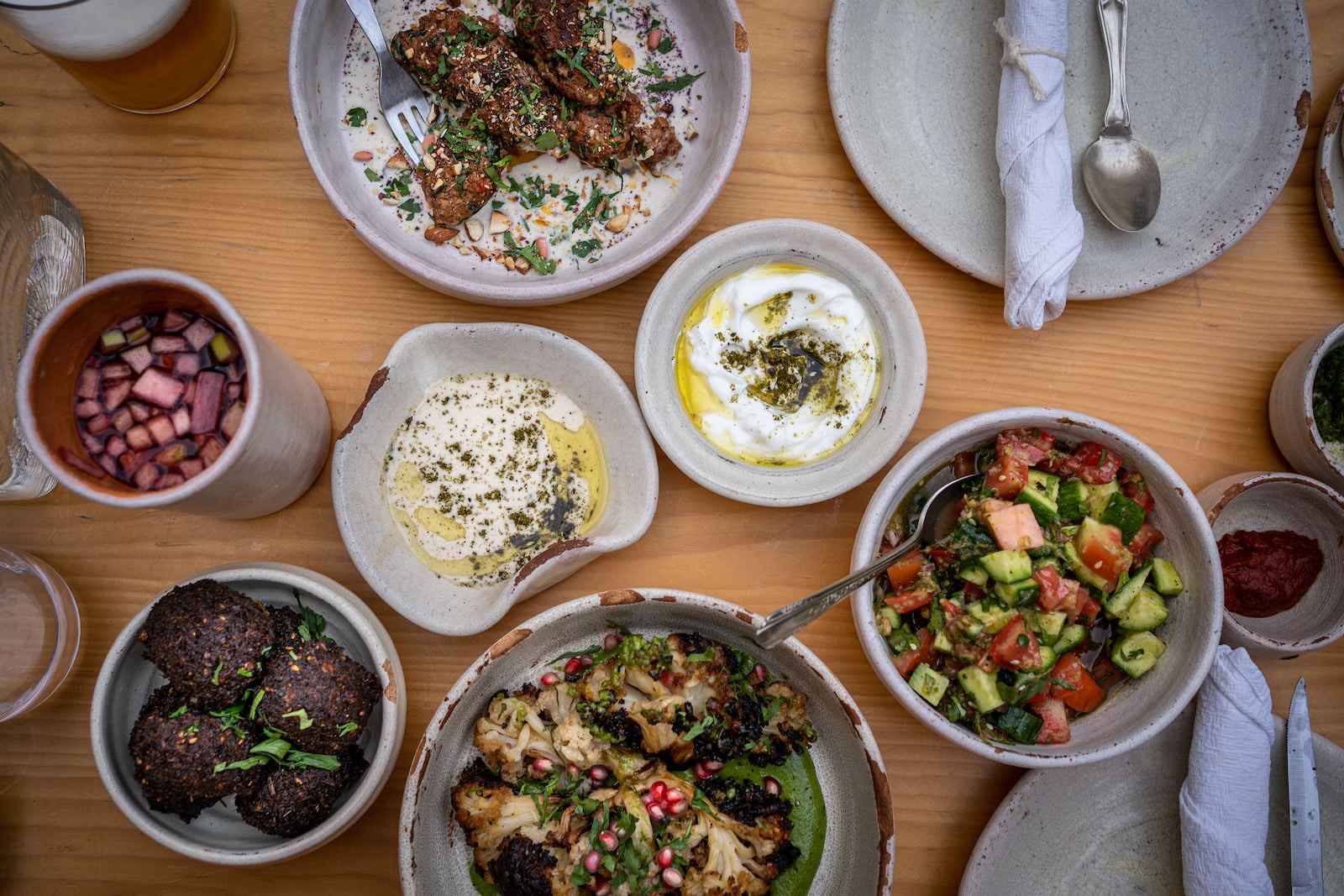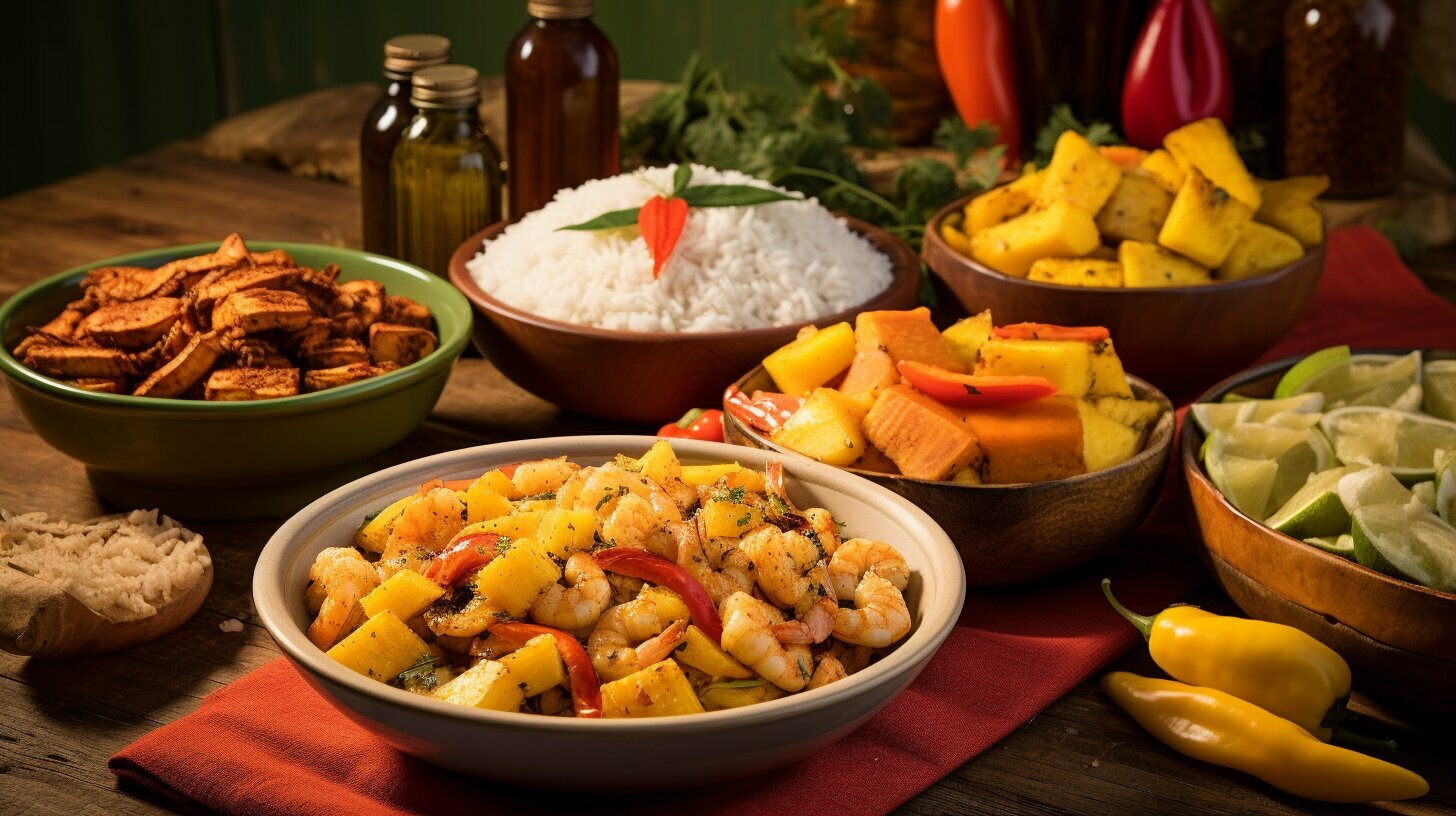Spanish and Portuguese cuisines are often compared due to their proximity and cultural similarities. However, while both have delicious and mouth-watering dishes, they have distinct differences in flavors, ingredients, and cooking techniques that set them apart. In this section, we will take a closer look at how Spanish cuisine differs from Portuguese cuisine and explore the unique features of each.
Key Takeaways:
- Spanish and Portuguese cuisines have distinct differences in flavors, ingredients, and cooking techniques
- While both have similarities due to their proximity and cultural roots, each has unique characteristics
- Exploring the differences between these two cuisines offers a rich culinary experience for food enthusiasts
Historical Influences on Spanish and Portuguese Cuisine
Spanish and Portuguese cuisines have been shaped by historical influences, each with its unique features and culinary contrasts.
The most significant historical influence on Spanish cuisine was the Arabic occupation that lasted for over 700 years. During this time, the Moors introduced ingredients such as almonds, saffron, and spices like cumin and cinnamon to Spanish cooking. The influence can be felt in dishes such as paella, which originated in the Valencia region, and is made with saffron and bomba rice.
Another influence on Spanish cuisine was the colonization of the Americas, which brought new ingredients such as tomatoes, potatoes, and peppers. These ingredients were incorporated into Spanish cuisine and led to the creation of dishes such as gazpacho, a cold soup made with tomatoes, cucumber, peppers, garlic, and olive oil.
On the other hand, Portugal’s cuisine was influenced by its maritime history. The country was a major player in the European spice trade, and this is reflected in the many spices used in Portuguese cuisine. For example, cinnamon is a common ingredient in Portuguese desserts such as pasteis de nata, a custard tart that is popular around the world.
Portugal’s former colonies in Africa, Asia, and South America also played a significant role in shaping the country’s cuisine. For example, the use of coconut milk in some Portuguese dishes can be traced back to the country’s former colonies in Asia and Africa.
Unique Features of Spanish and Portuguese Cuisine
Despite their shared history, Spanish and Portuguese cuisines have unique features that set them apart. One of the differences is the use of olive oil – while both countries use olive oil in their cooking, Spanish cuisine tends to use more of it than Portuguese cuisine.
Another difference is the prominence of seafood in Portuguese cuisine. The country’s location on the Atlantic coast means that seafood is readily available and forms a significant part of the cuisine. Some of the most popular dishes include bacalhau (salt cod) and grilled sardines.
Ultimately, the historical influences on Spanish and Portuguese cuisine have created two distinct culinary traditions with their unique flavors and ingredients. Understanding these differences allows food enthusiasts to appreciate the richness of these cuisines fully.
Flavors and Ingredients in Spanish Cuisine
Spanish cuisine is renowned for its diverse range of flavors and ingredients, which are influenced by the country’s rich gastronomic history. The cuisine varies greatly depending on the region, with each area showcasing its own unique dishes and specialties. Spanish food is also distinct from Portuguese food, with variations in ingredients and techniques.
One of the defining features of Spanish cuisine is its use of fresh, high-quality ingredients. Olive oil and garlic are staples in many dishes, as well as tomatoes, onions, and peppers. Seafood is also prominent in many coastal regions, with sardines and anchovies being popular choices. Inland areas rely more on meats such as pork and beef, with cured ham, chorizo, and morcilla (black pudding) being common.
Another key ingredient in Spanish cuisine is saffron, which is used in the famous dish paella. Other common herbs and spices used include paprika, oregano, and thyme. Spanish cuisine also features a variety of cheeses, such as manchego and cabrales.
Spanish gastronomy varies greatly between regions, with each area showcasing its unique flavors and ingredients. The Basque Country is known for its pintxos (small snacks), seafood, and Txakoli wine, while Catalonia is renowned for its rich, slow-cooked dishes such as suquet de peix (fish stew) and botifarra amb mongetes (sausage with beans).
Regional Variations in Spanish Cuisine
| Region | Specialties |
|---|---|
| Andalusia | Gazpacho, fried fish, salmorejo |
| Basque Country | Pintxos, txakoli wine, seafood |
| Catalonia | Suquet de peix, botifarra amb mongetes |
| Galicia | Pulpo a la gallega, empanadas, Albariño wine |
Overall, Spanish cuisine is a celebration of fresh, high-quality ingredients and regional specialties. The distinct flavors and ingredients of each area contribute to a diverse and vibrant gastronomic culture.
Flavors and Ingredients in Portuguese Cuisine
Portuguese cuisine is known for its rich and diverse flavors, which stem from the country’s history of maritime exploration and global trade. The use of spices, herbs, and fresh ingredients, combined with traditional cooking methods, creates a unique gastronomic experience that is distinct from its Spanish neighbor.
Distinctive Ingredients
One of the key differences between Spanish and Portuguese cuisine is the use of ingredients. While Spain heavily relies on olive oil, garlic, and tomatoes, Portugal’s cuisine features an array of seafood, meats, and vegetables.
One of the most iconic ingredients in Portuguese cuisine is bacalhau, or salt cod. This fish is central to many traditional dishes, such as bacalhau à brás, which combines shredded cod with eggs, onions, and potatoes. Other popular seafood options include sardines, octopus, and clams.
Meat also plays a significant role in Portuguese cuisine, with dishes featuring pork, beef, and chicken. Cozido à portuguesa is a hearty stew that combines different meats and vegetables, while leitão assado (roast suckling pig) is a famous dish from the Bairrada region.
In addition to seafood and meat, Portuguese cuisine features a variety of vegetables, such as tomatoes, cabbage, and kale. Soups, such as caldo verde, are popular throughout the country and often include chorizo or other cured meats.
Regional Variations
Like Spain, Portugal’s cuisine is heavily influenced by regional variations. Each region has its own specialties and local ingredients that are central to its culinary identity.
The north of Portugal is known for its hearty stews and meat dishes, while the coastal regions feature a variety of seafood options. The Alentejo region is famous for its bread-based dishes, such as açorda, a soup made with bread, garlic, and coriander. The Azores islands are known for their cheese and unique seafood dishes, such as lapas (limpets).
Another regional specialty of Portuguese cuisine is pastéis de nata, or custard tarts. These small egg custard tarts originated in the city of Belém and have become a beloved dessert throughout Portugal and beyond.
Culinary Contrasts
While Spanish and Portuguese cuisines share some similarities, the differences in their flavors and ingredients are what sets them apart. The use of spices and fresh ingredients in Portuguese cuisine creates a unique flavor profile that cannot be found in Spanish dishes.
From the iconic bacalhau to the regional specialties of each region, Portuguese cuisine offers a diverse and flavorful gastronomic experience that is distinct from its Spanish counterpart.
Cooking Techniques in Spanish Cuisine
Spanish cuisine features a variety of cooking techniques that contribute to its unique flavors and textures. One of the most prominent techniques is frying, which is used in many dishes, including the beloved churros. To achieve the perfect crispiness, the batter is piped directly into hot oil, resulting in a crunchy exterior and soft, doughy interior.
Another popular cooking technique in Spanish cuisine is grilling, which is often used for meats and vegetables. The use of charcoal adds a distinctive smoky flavor to the dishes, enhancing their overall taste. One of the most famous examples of Spanish grilled food is the popular tapa known as “pinchos morunos,” which features marinated pork skewers cooked over an open flame.
Finally, “escabeche” is a cooking technique that is commonly used in Spanish cuisine. It involves marinating food in a mixture of vinegar, oil, and spices, which gives the dish a tangy, acidic flavor. One of the most iconic dishes made using this technique is “escabeche de pollo,” which features marinated chicken cooked with onions and bell peppers.
Spanish vs Portuguese Cuisine
When comparing Spanish and Portuguese cuisine, it’s important to highlight the different cooking techniques used in each. While both cuisines share some similarities, such as the use of grilling and frying, Portuguese cuisine is perhaps more heavily influenced by stews and slow-cooking methods.
A classic example of traditional Portuguese slow-cooking is “cozido,” a hearty stew made with beans, vegetables, and various meats. The dish is simmered for hours, resulting in a rich, flavorful broth and tender meat that falls off the bone.
Another hallmark of Portuguese cuisine is the use of “cataplanas,” a type of copper or stainless steel cooking pot that resembles a clamshell. These pots are used to cook a variety of seafood dishes, such as the famous “cataplana de marisco,” which features a medley of shellfish cooked with onions, tomatoes, and white wine.
Overall, both Spanish and Portuguese cuisine boast unique cooking techniques that contribute to their distinct flavors and cultural significance. Whether you prefer the tangy, acidic taste of escabeche or the rich, hearty flavors of Portuguese stews, there’s no shortage of delicious options to explore.
Cooking Techniques in Portuguese Cuisine
Portuguese cuisine has a distinct set of cooking techniques that set it apart from Spanish cuisine. The Portuguese have a deep appreciation for slow-cooking and stewing, using a variety of meats and fresh seafood to create hearty dishes that are bursting with flavor.
A key example of this is Cozido à Portuguesa, a traditional stew made with beef, pork, chicken, sausages, and vegetables, all cooked together in a flavorful broth. Another popular dish is Bacalhau à Gomes de Sá, a casserole made with salt cod, potatoes, onions, and eggs.
One technique that is unique to Portuguese cuisine is the use of cataplanas, a type of cooking vessel that consists of two metal domes that are held together with a clamp. The cataplana is used to cook seafood dishes, such as Arroz de Marisco, a rice dish made with a variety of shellfish.
The Importance of Olive Oil
Olive oil is a staple in Portuguese cuisine, and is used to add flavor and texture to dishes. The Portuguese have a long history of olive oil production, and the country is home to a variety of olive groves that produce high-quality oil.
One popular dish that highlights the use of olive oil is Açorda Alentejana, a bread soup made with garlic, poached eggs, and coriander. The soup is finished with a drizzle of olive oil, which adds a rich, savory flavor to the dish.
Grilled Meat and Seafood
The Portuguese are also known for their grilled meats and seafood. One popular dish is Espetada, a skewered meat dish that is seasoned with garlic and bay leaves, and grilled over an open flame.
Seafood is also a key component of Portuguese cuisine, with fresh fish and shellfish being abundant. Grilled sardines, served with a drizzle of olive oil and fresh lemon juice, are a popular and simple dish that is enjoyed throughout Portugal.
Overall, the cooking techniques used in Portuguese cuisine highlight the country’s love for slow-cooking, fresh seafood, and the use of high-quality olive oil. These techniques, combined with the unique flavors and ingredients of Portuguese cuisine, make for a truly exceptional culinary experience that is distinct from Spanish cuisine.
Regional Specialties and Popular Dishes
Spain and Portugal both boast a rich culinary heritage, with unique dishes and flavors that are representative of their respective cultures. While both countries share some similarities in their cuisines, there are distinct differences that set them apart. Here, we will explore some of the most popular dishes and regional specialties from each country, highlighting the contrasts between them.
Spanish Dishes
Spanish cuisine is known for its bold flavors and fresh ingredients, with regional specialties that vary depending on the area. Some popular dishes include:
- Paella: This iconic dish hails from Valencia and is made with saffron-infused rice, seafood, and vegetables.
- Tortilla española: A Spanish omelette made with potatoes and onions that is often served as a tapa.
- Gazpacho: A cold soup made with tomatoes, peppers, and other vegetables that is perfect for hot summer days.
- Churros: A popular breakfast or dessert food made with fried dough and served with hot chocolate for dipping.
Portuguese Dishes
Portuguese cuisine is characterized by its heavy use of seafood, spices, and olive oil. Some popular dishes include:
- Bacalhau: A national dish made with salt cod that is prepared in numerous ways, such as baked with potatoes or in a creamy casserole.
- Francesinha: A hearty sandwich consisting of layers of meats and cheese, topped with a beer-based sauce and a fried egg.
- Sardinhas assadas: Grilled sardines are a staple of Portuguese cuisine, often served with roasted potatoes and a simple salad.
- Pasteis de nata: These small custard tarts are a popular dessert in Portugal, with a crispy pastry shell and a creamy, sweet filling.
Whether you prefer the bold and flavorful dishes of Spain or the seafood-centric cuisine of Portugal, both countries offer an array of delicious options for food enthusiasts. So why not take a gastronomic journey and explore the unique tastes of these neighboring nations?
Conclusion
Spanish and Portuguese cuisines boast unique flavors, ingredients, and cooking techniques that differentiate them from other European cuisines. The distinct characteristics of each cuisine can be attributed to historical influences, including colonization and trade, as well as regional differences.
Spanish cuisine features bold flavors, including the use of saffron, paprika, and garlic, while Portuguese cuisine leans towards lighter and more delicate flavors, incorporating ingredients such as cod, sardines, and olive oil. Each cuisine has its own unique cooking techniques, such as the use of clay pots in Spanish cooking and slow-cooking methods in Portuguese cuisine.
Regional specialties and popular dishes from both cuisines showcase the diverse culinary experiences available in Spain and Portugal, from the paella in Valencia to the bacalhau in Lisbon.
Overall, the differences between Spanish and Portuguese cuisine contribute to a vibrant gastronomic scene in both countries, offering a rich culinary experience for food enthusiasts.
FAQ
Q: How does Spanish cuisine differ from Portuguese cuisine?
A: Spanish and Portuguese cuisines have their own unique flavors, cooking styles, and cultural influences. While both cuisines share similarities due to their geographical proximity, there are distinct differences in ingredients, flavors, and regional specialties.
Q: What are the historical influences on Spanish and Portuguese cuisine?
A: Spanish and Portuguese cuisines have been shaped by various historical influences. Spanish cuisine has been influenced by Moorish, Roman, and Mediterranean cultures, while Portuguese cuisine has been influenced by Moorish, Roman, and Atlantic cultures. These influences have contributed to the unique characteristics of each cuisine.
Q: What are the key flavors and ingredients in Spanish cuisine?
A: Spanish cuisine is known for its bold flavors and diverse ingredients. Classic Spanish ingredients include olive oil, garlic, saffron, paprika, and a variety of seafood and meats. Regional variations in Spain also contribute to the diversity of flavors in Spanish cuisine.
Q: What are the distinct flavors and ingredients in Portuguese cuisine?
A: Portuguese cuisine boasts flavors influenced by the sea, with a focus on fish and seafood. Other common ingredients include olive oil, garlic, onions, tomatoes, and spices such as piri-piri and cinnamon. Each region in Portugal also has its own unique dishes and traditional ingredients.
Q: What are the cooking techniques commonly used in Spanish cuisine?
A: Spanish cuisine utilizes various cooking techniques to bring out flavors. Some common techniques include grilling, frying, stewing, and braising. The use of a traditional Spanish clay pot called “olla” is also prevalent in Spanish cooking.
Q: What are the cooking techniques central to Portuguese cuisine?
A: Portuguese cuisine relies on cooking techniques such as grilling, baking, roasting, and boiling. Slow-cooking methods are also popular, resulting in tender and flavorful dishes. The use of traditional Portuguese clay cookware, like “cataplanas,” adds to the unique cooking techniques in Portuguese cuisine.
Q: What are some regional specialties and popular dishes in Spanish and Portuguese cuisines?
A: Spain is known for its paella, tapas, gazpacho, and jamón ibérico. In Portugal, popular dishes include bacalhau (salted cod), pastéis de nata (custard tarts), caldo verde (kale soup), and francesinha (a meat sandwich). Each region within Spain and Portugal has its own unique specialties and local delicacies.



